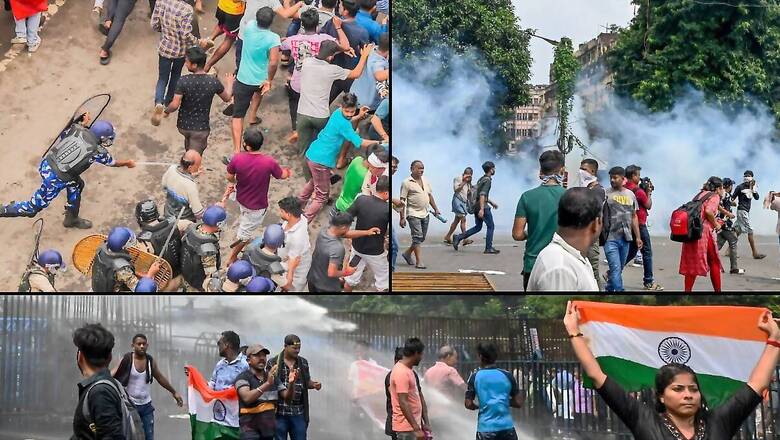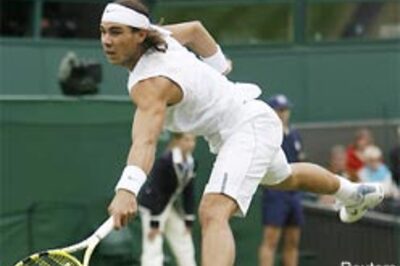
views
Had there been 24×7 TV news in India back in July 1993, the scenes on the streets of Kolkata on Tuesday may have looked very familiar to many people. On July 21, 1993, the then imperious Chief Minister Jyoti Basu, ensconced in Writers Building, sent the Kolkata Police out to quell a protest march led by a firebrand 38-year-old woman against his Left Front government. Instead, parallels are being drawn with Sheikh Hasina and the visuals from Dhaka earlier this month.
The question is whether that firebrand, now a very imperious 69-year-old third-term CM, sitting in Nabanna (she decommissioned Writers Building as the state secretariat to avenge her ordeal in 1993) has feelings of déjà vu. No matter how much Kolkata Police and party spokesmen defend the lathi-charges, tear-gassing and water-cannoning, the images on instant recall and on thousands of social media posts will be of unarmed protestors being set upon by the authorities.
Even if Mamata Banerjee does not want to remember her Communist bete noire, she should remember another powerful woman CM, Sheila Dikshit, who was in charge when there were similar demonstrations and police crackdowns in Delhi: lathi-charges, teargas, water cannons, barricades—and determined protestors demanding justice for Nirbhaya. Dikshit’s unrelenting attitude cost her and the Congress Party (then ruling at the state level and the centre) very dear indeed.
The images of yellow barricades chained together at the foot of Raisina Hill in the heart of the Capital in December 2012 seemed unreal to many Delhiites watching on TV. When policemen in full riot gear beat back clearly ‘civilian’ protestors, and water cannons were turned on them in the freezing weather, viewers’ disbelief turned to anger and then disgust. In the Assembly elections a year later, Congress came third—and it marked the rise of Arvind Kejriwal.
That should have made all future CMs chary of using the same tactics again. But clearly memories of some politicians are short. Yet the bandobast of the Kolkata Police on Tuesday to deal with the protest march gave the impression that they expected nothing short of an invading Army. Steel barricades welded (not just tied) together to a height of 6 feet, bamboo palisades and heavy metal containers (used to transport cargo on ships and trains) were placed across key roads!
All this to stop people who had only national flags and an assortment of placards. To be sure, no doubt thanks to the presence of TV media and countless phone cameras, unlike in 1993, Kolkata Police did not fire live ammunition at the protestors this time. Back then 13 people had died in police firing that day; this time they were beaten back by lathis, teargas and water cannons. But the state governments both then and now, justified Kolkata Police’s heavy-handedness.
Perhaps the TMC spokesmen were buoyed by the precedent of the Kamduni rape-murder, that that convulsed West Bengal in June 2013 and had led to eerily similar statements by Banerjee that the rapist(s) would hang. There were protests led by women from Kamduni who were friends of the victim, and candle-light marches by civil society demanding a CBI investigation. Their demand was not met and the wheels of “justice” turned painfully slowly. Not always forward either.
A sessions court convicted three men for the rape-murder in 2016 and awarded the death penalty to all of them. Justice appeared to be served and the CM seemed to have made good on her “promise”. Only, in 2023—a decade after the rape-murder—the Calcutta High Court acquitted one of them and commuted the death sentence of two others to life imprisonment! That led to renewed protests by the women of Kamduni and also “civil society”. But eventually, it died down…
That must have led to a realisation in some circles that there is a limit to public outrage, no matter how heinous the crime. There have been many rapes and rape-murders in West Bengal before and after Kamduni, and sadly, even after RG Kar. The objective, therefore, is to wear out the public’s outrage. But the excessive actions taken against apolitical protestors on Tuesday have achieved exactly the opposite, even if they were “successfully” prevented from reaching Nabanna.
There were, of course, also “charges” that the protestors had political connections, as if that is illegal or somehow immoral. Every Indian has a right to vote and at least 60 per cent of us do in every election. That indicates political preference but that does not mean there was an ulterior motive for demanding “Justice for RG Kar” and safety for everyone. And it cannot be denied that even political protests are an integral part of democratic processes and cannot be dubbed unwarranted.
That the BJP, as the main opposition party in the state, has every right to call for bandhs and other protests also cannot be denied. It has 66 seats in the West Bengal Assembly—about one-fourth of the House—and has an obligation towards its constituents to take the government to task. And this issue certainly demands a political response. For TMC to insist that the BJP or even the disproportionately vocal Left parties should stay out of this issue is patently disingenuous.
That the Congress has decided to stay largely silent and invisible during the past tumultuous fortnight cannot but further damage the party’s image in the state at a time when a centrist space could be carved out again. None of the Gandhis have found time to visit Kolkata so far, but people may remember that the extended Gandhi-Vadra clan even participated in a candlelight vigil in New Delhi in April 2018 to demand justice for the rape-murder victims of Kathua and Unnao.
One aspect of the protests may escape those who are unfamiliar with the situation in the state. Police officers ominously told the media that ‘troublemakers’ of Tuesday’s protests would be identified, and action would be taken. The threat inherent in that statement would be apparent to all state residents as non-TMC voters have been grievously assaulted in the aftermath of assembly and general elections. Openly protesting against the government inevitably invites worse.
That so many people came without masks, braved police lathis and water cannons and spoke about their dissatisfaction with the actions of the state government should send a message to Nabanna too. Only in hindsight did the Left Front realise that police heavy-handedness on 21 July 1993 became a turning point in the state’s politics. Will the TMC realise that the events of 27 August 2024 and whatever happens in the coming days could prove to be equally detrimental?
The author is a freelance writer. Views expressed in the above piece are personal and solely those of the author. They do not necessarily reflect News18’s views.




















Comments
0 comment